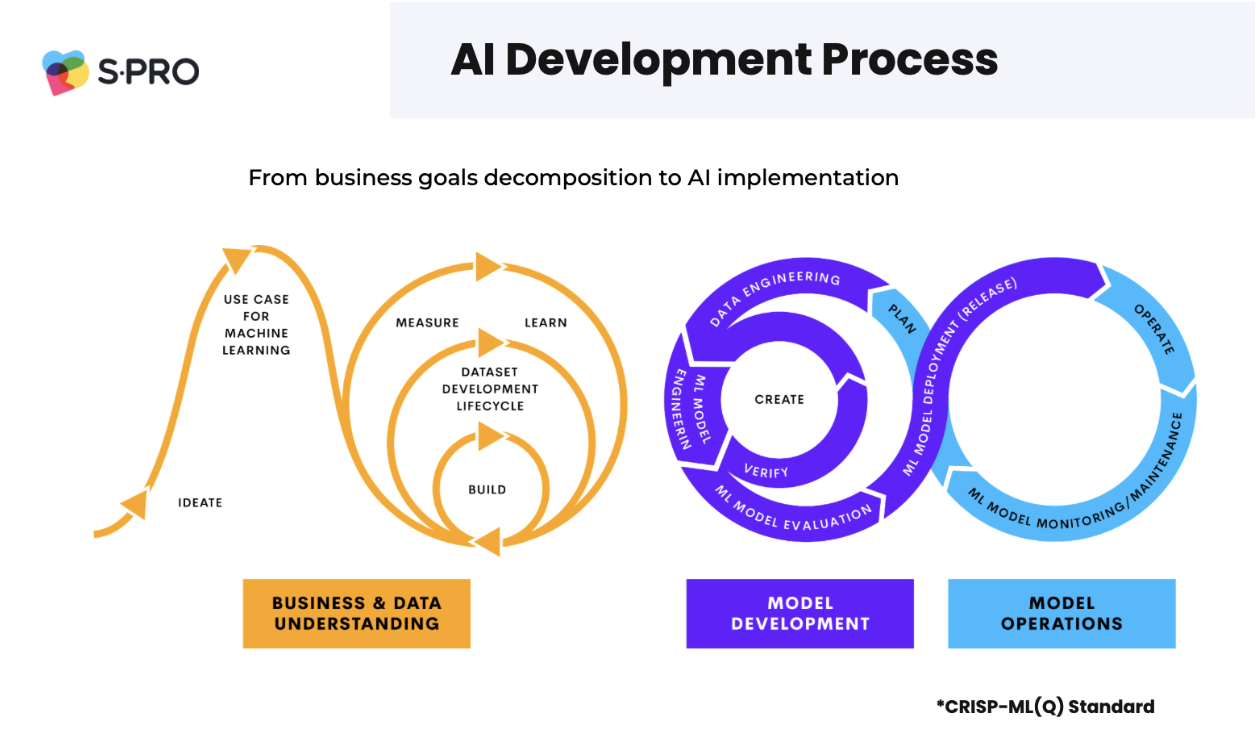Want to discover the MLOp meaning? This article explains machine learning operations in depth, navigating you through the latest trends, challenges, solutions, tools, and use cases of modern ML model productionalization.
What Are MLOps?
MLOps, also known as Machine Learning Operations, is the mediator connecting data science and operations. This set of practices and principles makes the deployment, monitoring, and management of ML models in real-world settings as smooth as possible. Simply put, it’s a way businesses can produce and maintain their machine learning solutions effortlessly throughout the ML model lifecycle.
The MLOps solutions comprise of two primary phases:
- Experimental phase — including data collection, analysis, and preparation, ML model selection, development, and testing, and data experimentation with the model’s hyperparameters tuning
- Production phase — including data transformation, ML model training, deployment, operating, and performance monitoring in production environments
You can also refer to the above as the development and operations stages.
Role of MLOps in ML Products
Machine learning is now more than a research field. It’s a lucrative investment for businesses. And those companies that aim to deliver ML products quickly and hassle-free reap all the benefits of MLOps, which are:
Faster Time-to-Market
MLOps simplifies ML production by automating tasks like model deployment and maintenance. It also speeds up development, ultimately allowing businesses to roll out their solutions faster.
Optimised Workflows
By leveraging MLOps solutions, companies get a straightforward framework on how to develop, train, and maintain their ML model in the most effective way. As a result, the data science, engineering, and production teams collaborate better.
Ensured Model Reliability
ML models require constant attention to deliver accurate results. MLOps sets up a system for watching them in real-time, so if anything starts going wrong with the models or if they’re not performing as expected, businesses can detect and fix the issues right away.
Continuous Improvement
Incorporating ML into products is not a one-time effort but an ongoing journey. MLOps, along with CI/CD, fosters continuous improvement by using feedback loops and retraining models.
Reduced Risks
Other benefits of MLOps include reducing the risks associated with ML product production. Using this approach, businesses get real-time model monitoring, automated testing, and regulatory compliance — the practices necessary for mitigating any issues.
Latest Trends in ML Model Productionalization
Let’s now see what the future holds for the MLOps industry. Here are some recent trends:
- Market surge. The global MLOps market is projected to skyrocket, reaching $16.61 billion by 2030, according to Grand View Research. It will grow by 39.7% yearly from 2023 to 2030, representing a significant shift in organisations willing to adopt ML model productionalization.
- Increased investment. In 2023, organisations are planning substantial investment in MLOps solutions, with 98% of respondents aiming to increase spending by at least 11%. A remarkable 58% plan to elevate spending by over 25%, reflecting growing confidence in MLOps as a trigger for business growth.
- Widespread adoption. MLOps has firmly established itself, with 85% of ClearML survey respondents in 2022 having dedicated budgets for it. An additional 14% plan to allocate funds in 2023.
- MLOps platforms’ dominance. MLOps platforms led the market in 2022, making up 76% of global revenue. As Grand View Research suggests, organisations will rely on these platforms further to increase their ML projects’ reliability, scalability, and efficiency.
- On-premise MLOps rise. On-premise MLOps adoption surged in 2022, capturing over 58% of revenue. This trend reflects businesses’ desire to bring their operations in-house for increased data privacy and control.
Challenges in ML Productionalization
When jumping into ML productionalization, businesses face several hurdles. Let’s discuss them so you can prepare for the potential issues beforehand.
Difficulties in Generating Business and Commercial Value
ML benefits businesses in numerous ways, from automating tasks to improving decision-making, yet its effective productionalization may be complex. Look at the following numbers from the ClearML survey:
- 86% of organisations faced difficulties when harnessing ML
- 29% of companies found it very challenging to unlock their ML solution’s business value
- 71% of businesses noted their struggles with generating revenue due to hurdles in large-scale ML implementation
Hopefully, MLOps use cases cover these issues and help businesses benefit from their ML products to the fullest.
Talent Shortage
Talent scarcity is another challenge organisations may face when handling ML productionalization on a larger scale. About 29% of companies surveyed by ClearML consider it their primary issue.
ML Deployment and Maintenance Complexity
ML project deployment is a significant hurdle, given the diverse nature of ML solutions and their specific hosting and deployment requirements. Maintaining those is no easier, especially for large-scale products. Learning how to productionize ML models with MLOps may be a viable solution to this challenge.
Solutions and Tools for Modern MLOps
Choosing the right solutions is critical for streamlining ML productionalization. Here’s the MLOps tools list you should consider:
- MLOps platforms — cover all ML workflows, including data preparation, model training, deployment, and monitoring. Examples are TensorFlow, MLflow, and Kubeflow.
- Containerisation and orchestration — put ML models into portable containers. Examples include Docker and Kubernetes.
- CI/CD — automate the ML model integration, testing, and deployment. Popular tools for MLOps are Jenkins and CircleCI.
- Model version control — track changes in ML models. Git is a decent example.
- Monitoring and logging — track model performance and detect issues. Grafana and ELK Stack will help.
- Collaboration — facilitate cooperation between cross-functional teams. Examples are Slack, Microsoft Teams, and Confluence.
- Cloud services — store data on ML models. AWS, Google Cloud, and Microsoft Azure are the most prominent examples.
- Model deployment — productionize ML models. A suitable tool is REST API.
MLOps Use Cases
Wondering about the real-world applications of MLOps? S-PRO has got you covered with examples. We’ve implemented ML products for several clients, combining data science, software engineering, and operations.
Muuuvr
Muuuvr is a groundbreaking player in Fintech that offers an active-data-for-crypto platform. Our team had to ensure a scalable architecture and establish a centralised community hub for this client. We used AWS services, AWS group auto-scaling, a Salary system, and a container to handle these tasks.
Modo
Modo is a data analysis company that provides market insights for the renewable energy sector. S-PRO handled data integration and processing, real-time market monitoring, data visualisation, and insights generation to power our client’s platform. We’re currently working on services that will expose the ML models. Our experts leverage the AirFlow task orchestrator for MLOps.
Both projects work stably, we have good tools for monitoring, control and scaling.
Our Approach to MLOps
Efficiency is the core reason why we use MLOps methodology. It allows us to build AI/ML life cycles fast and at high quality. The tools for MLOps we use in most cases are:
- Amazon and Google Cloud as cloud providers
- Amazon SageMaker as a full-fledged platform for creating prototypes for ML services quickly and efficiently
- Our custom deployment pipelines as solutions for more complex projects
Why Invest in MLOps?
If you’re still hesitating about whether leveraging MLOps solutions for ML productionalization is a good idea, let us outline the reasons to invest in this approach. Here are the main ones:
- Improving your workflow efficiency and accelerating time-to-market
- Identifying issues with the ML model early on
- Minimising risks associated with security, regulatory compliance, and model performance
- Making your ML solutions scalable from the beginning
- Optimising your expenses through automated processes
- Gaining competitive advantage by delivering high-quality ML products faster and more reliably
- Increasing customer satisfaction with robust ML products
Benefits of MLOps: Enhancing Machine Learning Lifecycle Efficiency
MLOps combines machine learning and operations to streamline software development processes, making them more structured, effective, and error-free. It results in faster time to market, as MLOps automate manual tasks and shift the focus to product and business requirements. Let’s review the main benefits of MLOps:
- Automation of manual processes
Data processing requires a lot of manual work, which is prone to human errors. MLOps solutions automate most of the time-consuming activities and helps humans concentrate on business logic and efficiency.
- Team productivity
As engineers focus on tasks where human effort is needed, they achieve greater productivity and better time management. A combination of human work and machine automation is a powerful mix that allows organization achieve better results in a shorter period of time.
- Focus on data and better model quality
MLOps market is all about standard rules and practices that lead to better model quality, as machine learning models regularly monitor models and prevent them from becoming obsolete or outdated.
- Regulatory compliance
MLOPs also constantly track is models comply with the regulations in different domains. It results in models transparency, as well as the lack of bias and hallucinations.
- Scalability
MLOPs allow overseeing, controlling, and monitoring models for continuous integration, delivery, and deployment, which turns into better scalability and higher quality.
Conclusion
The benefits of MLOps are undeniable. Imagine streamlining ML production processes and speeding up your solution’s launch. Add improved cross-team cooperation and better customer experience to this, and you’ll have no doubts about MLOps’ practicality. Want to leverage this transformative approach? Contact S-PRO to discuss your ML project.





